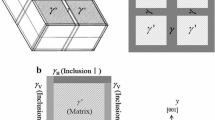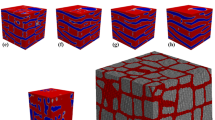Abstract
An anisotropic micromechanical model based on Mori-Tanaka method is developed to calculate the effective elastic moduli of Ni-based single crystal superalloys. In the micromechanical model, the γ' precipitate with very high volume fraction is regarded as matrix, γ phase is divided into three parts as three different kinds of inclusions, and the actual cubic structure and orthogonal anisotropy properties of γ phase and γ′ precipitate are taken into account. Based on this anisotropic micromechanical model, the effective elastic moduli of Ni-based single crystal superalloys composite materials is obtained, and the influences of volume fraction and elastic constants of γ′ precipitate on the effective elastic moduli are also discussed. The results provide useful information for understanding mechanical behavior of composite materials in Ni-based single crystal superalloys and other anisotropic polygonal inclusion problem.
Similar content being viewed by others
References
Hershey A V. The elasticity of an isotropic aggregate of anisotropic cubic crystals. J Appl Mech, 1954, 21: 236–241
Hill R. Continuum micro-mechanics of elastoplastic polycrystals. J Mech Phys Solids, 1965, 13: 89–101
Hill R. A self-consistent mechanics of composite materials. J Mech Phys Solids, 1965, 13: 213–222
Hutchinson J W. Elastic-plastic behaviour of polycrystalline metals and composites. Proc R Soc A-Math Phys Eng Sci, 1970, 319: 247–272
Budiansky B. On the elastic moduli of some heterogeneous materials. J Mech Phys Solids, 1965, 13: 223–227
Weng G J. Some elastic properties of reinforced solids, with special reference to isotropic ones containing spherical inclusions. Int J Eng Sci, 1984, 22: 845–856
Benveniste Y. A new approach to the application of Mori-Tanaka’s theory in composite materials. Mech Mater, 1987, 6: 147–157
Mori T, Tanaka K. Average stress in matrix and average elastic energy of materials with misfitting inclusions. Acta Metall, 1973, 21: 571–574
Eshelby J D. The determination of the elastic field of an ellipsoidal inclusion, and related problems. Proc R Soc A-Math Phys Eng Sci, 1957, 241: 376–396
Eshelby J D. Elastic inclusions and inhomogeneities. Prog Solid Mech, 1961, 2: 89–140
Wang H, Li Q. Prediction of elastic modulus and Poisson’s ratio for unsaturated concrete. Int J Solids Struct, 2007, 44: 1370–1379
Gong S, Li Z, Zhao Y Y. An extended Mori-Tanaka model for the elastic moduli of porous materials of finite size. Acta Mater, 2011, 59: 6820–6830
Puchi-Cabrera E S, Staia M H, Iost A. A description of the composite elastic modulus of multilayer coated systems. Thin Solid Films, 2015, 583: 177–193
Zhu Y, Dui G. Micromechanical modeling of the stress-induced superelastic strain in magnetic shape memory alloy. Mech Mater, 2007, 39: 1025–1034
Zhu Y, Yu K. A model considering mechanical anisotropy of magnetic- field-induced superelastic strain in magnetic shape memory alloys. J Alloys Compd, 2013, 550: 308–313
Zhu Y, Dui G. Model for field-induced reorientation strain in magnetic shape memory alloy with tensile and compressive loads. J Alloys Compd, 2008, 459: 55–60
Chang J C, Allen S M. Elstic energy changes accompanying gamma-prime rafting in nickel-base superalloys. J Mater Res, 1991, 6: 1843–1855
Miyazaki T, Nakamura K, Mori H. Experimental and theoretical investigations on morphological changes of ?' precipitates in Ni-Al single crystals during uniaxial stress-annealing. J Mater Sci, 1979, 14: 1827–1837
Ratel N, Bruno G, Bastie P, et al. Plastic strain-induced rafting of precipitates in Ni superalloys: Elasticity analysis. Acta Mater, 2006, 54: 5087–5093
Wu W P, Guo Y F, Dui G S, et al. A micromechanical model for predicting the directional coarsening behavior in Ni-based superalloys. Comp Mater Sci, 2008, 44: 259–264
Li S Y, Wu W P, Chen M X. An anisotropic micromechanics model for predicting the rafting direction in Ni-based single crystal superalloys. Acta Mech Sin, 2016, 32: 135–143
Zhou L, Li S X, Chen C R, et al. Three-dimensional finite element analysis of stresses and energy density distributions around ?' before coarsening loaded in the [110]-direction in Ni-based superalloy. Mater Sci Eng-A, 2003, 352: 300–307
Siebörger D, Knake H, Glatzel U. Temperature dependence of the elastic moduli of the nickel-base superalloy CMSX-4 and its isolated phases. Mater Sci Eng-A, 2001, 298: 26–33
Fahrmann M, Hermann W, Fahrmann E, et al. Determination of matrix and precipitate elastic constants in Ni-base model alloys, and their relevance to rafting. Mater Sci Eng-A, 1999, 260: 212–221
Mura T. Micromechanics of Defects in Solids. 2nd Edition. Dordrecht: Kluwer Academic Publishers, 1987
Onaka S, Kobayashi N, Kato M. Two-dimensional analysis on elastic strain energy due to a uniformly eigenstrained supercircular inclusion in an elastically anisotropic material. Mech Mater, 2002, 34: 117–125
Pan E. Eshelby problem of polygonal inclusions in anisotropic piezoelectric full- and half-planes. J Mech Phys Solids, 2004, 52: 567–589
Ting T C T. Anisotropic Elasticity: Theory and Applications. Oxford: Oxford University Press, 1996
Author information
Authors and Affiliations
Corresponding author
Rights and permissions
About this article
Cite this article
Li, S., Wu, W., Li, Y. et al. An anisotropic micromechanical model for calculation of effective elastic moduli of Ni-based single crystal superalloys. Sci. China Technol. Sci. 60, 452–458 (2017). https://doi.org/10.1007/s11431-016-0101-5
Received:
Accepted:
Published:
Issue Date:
DOI: https://doi.org/10.1007/s11431-016-0101-5




